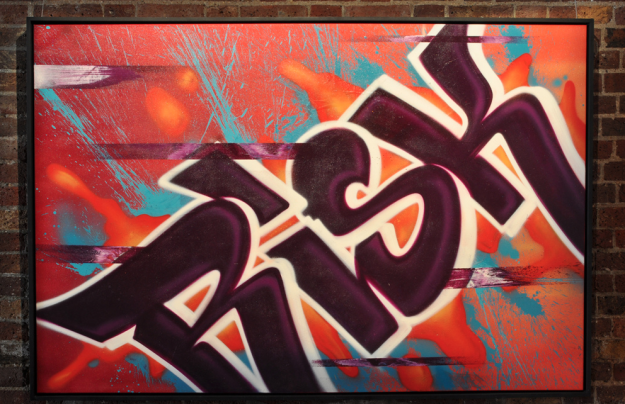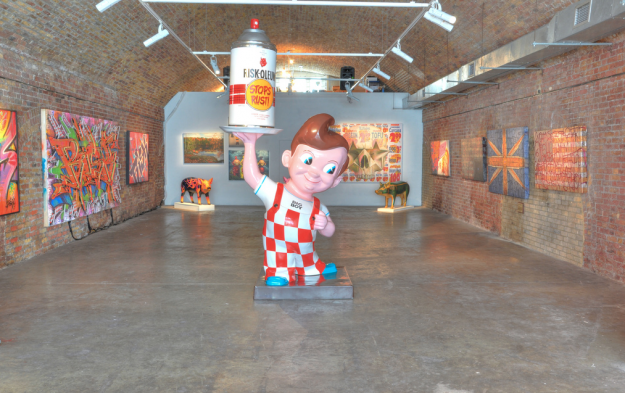
In the last week of Corey Helford‘s “Letters from America,” taking place right now Black Rat Projects in London, Vandalog caught up with another one of the participating artists, graffiti legend Risk. Grilling him on the nature of graffiti in the gallery and the place of collectives in the present day, Risk gave us an insight into his mediums, thoughts on working in the streets and showing alongside street artists.
Stephanie: How do you think the perception of graffiti has changed with the explosion of street art?
Risk: I think it is easier to relate to street art, therefore the perception of Graffiti is better as a whole.
S: Are they still separate movements?
R: Yes completely separate, yet cousins, so to speak…. Street art comes from the evolution of graffiti, the act of getting up and forcing society to look and think. It is an easier way, and more blatant. It’s only natural that we figure out quicker easier ways….
S: How do you think graffiti translates to canvas indoors? Does it have the same impact?
R: I think it’s the responsibility of the artists to make the canvas translate. Every artists should consider where they are showing and to whom. They have a unique opportunity to set the stage and convey what they want to convey to whom… As far as impact, I like to take advantage of the gallery setting and do things I can’t necessarily do on the streets, I.E. add neon, or create an environment etc.
S: Do you try to accomplish the same meaning with indoor work as your outdoor pieces?
R: It depends on what work you are referring to. My graffiti is still for me and my peers, however my mural work is for everyone, and it is meant to evoke stimulation and feelings thru color. My gallery work is meant to be visually timeless, yet here and now. It is all representations of things I have done on the streets but with added refined elements. So to answer your question they all overlap, yet they are all very different.
S: How did you get involved with the Corey Helford in the show in the first place?
R: I had a simultaneous opening with Crash at Corey Helford a few years back and I have been with them ever since.
S: Have you shown in London before? Why do you think there is such a draw for street art and graffiti in London?
R: I have never shown in London prior to this show however I attended a semester of school in London over twenty years ago, and I returned in the late 80’s to compete in a world graffiti championship held in Bridlington. A lot has changed since then….I think as a whole the draw to London and street art was helped along by the popularity and success of Banksy. Although many graffiti artists and hardcore enthusiasts including Banksy himself may attribute it to others before him you can not deny what he has accomplished. Simple facts are 99% of people are followers. The world is a big place the followers gain momentum….

S: With graffiti such a mainstream movement do you see the need for graffiti collectives now?
R: I understand the concept of increasing lobbying power for an arts infrastructure, and rallying behind a cause or belief. It also develops a higher group profile that benefits the individuals by association. But most importantly creates a hub for curators and commissioners to more easily locate potential talent. etc. however I also strongly believe that as a whole we need to be independent and not grouped together as one.
S: How have collectives changed over the years?
R: Collectives are way better now because you pick and choose who you want to be shown with. We are recognized and celebrated as individuals. I believe these types of shows are very positive. In the past I used to be offended when they had a show or event and all the graffiti got lumped into one. I remember being young and participating in events where each artist was allocated a specific space and the organizer or curator would say and “all the graffiti guys can paint this space together….” I think we’ve come a long way…
S: What pieces do you have in this show?
R: I have a sort of retrospective array of work in the show. I have traditional graffiti type canvas, a mixed media panel with neon and license plates, some new sculpture stuff I’ve been working on and a few of my more fine art color field type pieces.
S: What are your future plans?
R: My plan for the future is to never know the future. when you know the future it seems as if you know the end. I never want the ride to end….
Photo by No Lions in England
